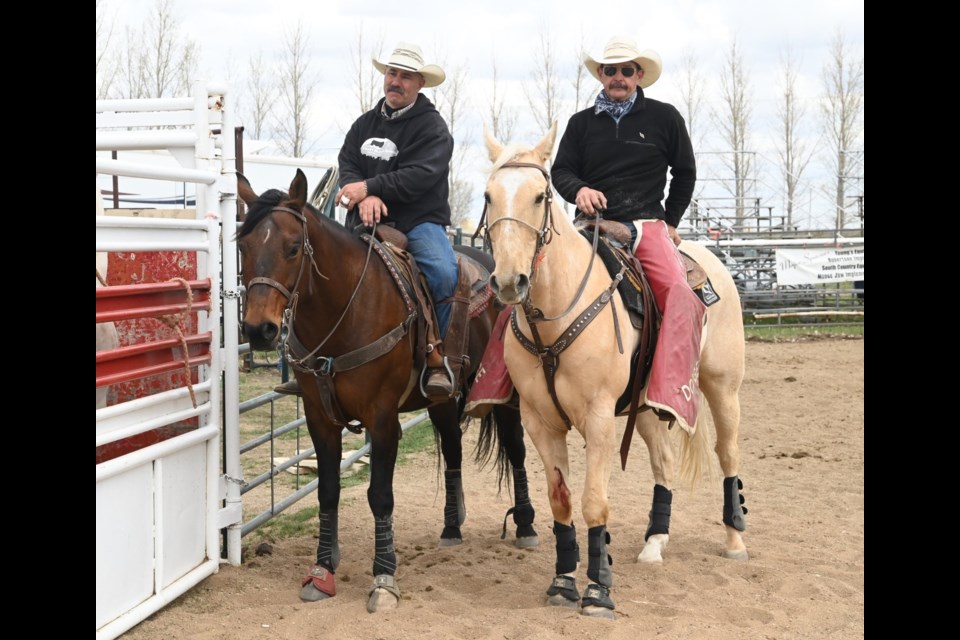Recently on Sunday, May 7th, the Moose Jaw Exhibition hosted the longest running rough stock, rodeo school in Canada.
A creation of the late Lee Bellows, the school is designed to teach the basics right up to the actual bareback riding, saddlebronc, and ranchbronc riding in a safe manner.
“Lee (Bellows) came up with the idea to teach the basics from the ground up to actual riding after people noticed the number of entries in rodeo riding events was dropping,” Ross Smith one of the co-organizers of the school said.
With the recent passing of Lee Bellows, a major part of the school’s organization fell on a group of individuals - Lee Sinclair, Theresa Bellows, Kelly Bryce, Shaun Francis and Ross Smith.
“We were the ones who took over a lot of the stuff Lee Bellows was in charge of,” Smith said, pointing out that there are “too many people to list who come to help out.”
He said volunteers are the core of the school and the reason for its continued success.
“There are many many volunteers in many aspects to create the longest running roughstock rodeo school in Canada,” he said, adding the reason for the school success was due to the volunteers and their enthusiasm for the school.
“The reason it continues to be successful is because the volunteers want to be here and truly want to help the kids learn…none of us are getting paid to do this.”
This year’s school had about 25 participants from Saskatchewan, Manitoba and Alberta, as well as one student originally from Prince Edward Island, who came out to learn the ropes.
In the past, the school has had participants from as far away as Australia and England.
The school accepts students from both rural and urban backgrounds. You don’t have to live on a ranch in order to take part.
“This is something that you do not have to be a ranch kid in order to come out to,” Smith said.
For at least one student this year, they had to go out and buy a cowboy hat and boots before they could participate.
The reason why the school can allow students with no ranch experience to participate is because of it’s from the ground-up training as well as safety orientation.
“Our school is very safety oriented. For a couple days prior, fundamentals, as well as safety, are instructed. Nobody gets on a horse until all of that is taught.”
“We try to make things as safe as you possibly can,” Smith said.
Smith is proud that in the many years the school has operated there has yet to be a serious injury. He admits though in the past there has been a few broken bones.
This year the school did have some minor injuries that could be best described as road rash and sore muscles.
Smith said running the school is very important, not just that it produces the next generation of rodeo riders, but at the same time it allows the passing down of knowledge from riders no longer on the circuit.
“Students learn from people that have been there, and they learn the proper way of doing things,” he said.
One of the key components to safety for the riders and horses are the pick up men.
Pick up men are the riders who follow and assist cowboys in various ways, such as getting them off horses once they’ve ridden the required eight seconds or directing horses away from riders in the rodeo ring.
Pick up men also direct the rodeo stock out of the arena and into safer holding pens.
“Pick up men are the lifeline and saviours,as well to the cowboy,” Smith said.
Despite many of the riders being bucked off, Smith pointed to the fact that the training they receive helps to prevent serious injuries.
“The way we stress safety at the school has given us a track record where we’ve have run hundreds and hundreds of horses through the ring and all we’ve had our scrapes, sprains, bruises, and a few minor broken bones,” he said.
“Stuff that is part of being a bronc rider.”
For female participants in this year’s school, they were able to take part in ranch bronc riding.
Ranch bronc riding differs from regular saddlebronc riding in that the sport makes use of an ordinary traditional saddle with a saddle horn and there’s differences in how the horse is ridden.
Smith said it was a privilege to be part of the school and throughout the event this year the school’s original organizer - the late Lee Bellows - was missed and remembered.
As part of that remembrance, a special belt buckle was presented to a long time volunteer at the school in Bellows memory. The award is planned to be a part of the rodeo school on an annual basis.




